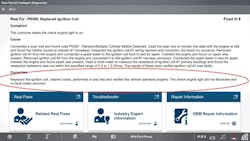Intelligent power balance testing on a Ford Focus
Do you remember the first cylinder power balance test you did? The answer to that could be very different depending on what era of the automotive repair industry you grew up in.
Internal combustion engines started being patented around the 1790’s. The first commercially successful internal combustion engine debuted in 1860. The 2-cylinder was developed in 1895 and the 4-cylinder later in 1898.
I imagine that the very first power balance test was performed on the world’s first vehicle equipped with a 4-cylinder engine, the German produced 1898 Daimler Phoenix.
So, back to the question. Do you remember the very first power balance test you did? I do. It was on my very first vehicle. It was a 1951 Chevy pickup with a 216 CID straight 6-cylinder engine that fouled a spark plug or two after every tank of gas.
By pulling one spark plug at a time and listening to the change in engine speed, I knew which cylinder was weak and needed to have the spark plug cleaned. This was a whole lot faster process than my only other option, removing all the plugs for a visual inspection.
The power balance test saved me time, and lots of it!
As a mechanic in those days, I discovered that Snap-on’s spark plug removal tool was a “must have” when HEI (high energy ignition) became more prevalent. Some of you may remember that becoming the path of least resistance with those systems could be a hair curling experience.
Let’s fast forward to today. Everything is fuel injected today, isn’t it? So, killing the spark to a cylinder while having fuel still pouring in would be unsafe. Not to mention the possibility of causing serious engine damage.
Disconnecting the fuel injector connector might be an option, but how time consuming would that be? It may even be impossible, right?
Let’s back up a minute.
The cylinder power balance test is a way of measuring the power contribution of each cylinder. That contribution should be relatively equal across all cylinders. The test, as we have already discussed, is disabling the operation of each cylinder, one at a time, while measuring the drop in RPMs.
What could cause power loss in a cylinder?
A cylinder may not be contributing because of an ignition issue, a fuel delivery problem, an air delivery problem or a mechanical failure such as a burnt valve or worn piston rings. There may be more than one cylinder involved. A blown head gasket, a cracked head or a cracked block results in a problem with adjacent cylinders.
What are some of the symptoms that would warrant a cylinder power balance test?
- Check engine light on with a misfire code
- Engine miss at idle or cruise speed
- Engine shudder during acceleration
- Poor fuel economy
- Failed emissions
So, back to the question of disconnecting a fuel injector and looking for engine speed changes. That works, but what kind of time does that take? Can you get to all the injectors without disassembly?
Let’s look at a real-world scenario, a case study that will guide us to the best course of action.
Check out our Ford balance power test quick tip using Snap-on scan tools.
Case study: 2016 Ford Focus
This is the part where we talk about Intelligent Ford Power Balance Testing.
Customer complaint: Check engine light is on and engine shudders during acceleration.
Step 1: Do a code scan – pre-scan
So, with a P0300 code (engine misfire detected) what is next?
I have always believed in following a diagnostic process. Remember the days when we used to follow a flow chart? That happens to be exactly what Fast-Track Intelligent Diagnostics is. Fast-Track Intelligent Diagnostics is not a product; it is a streamlined process that follows a path leading to the fastest way to pinpoint the problem.
What should be next? The second step, after the pre-scan, should always be checking for TSBs (technical service bulletins.) There could be literally hundreds of TSBs. Fast-Track Intelligent Diagnostics will filter it down to only those TSBs that are relative to the problem. In this case, we do have one relative TSB on ignition coil testing.
Next step is to check SureTrack for commonly replaced parts. This is not to pinpoint the problem, but it is a great compass to get you looking in the right direction. As you can see, the most common issues are ignition components.
To narrow it down even further, there is a test we should go to now. We need to determine where the problem cylinder is. You guessed it, there's a special feature offered on Snap-on diagnostic tools specific to Ford vehicles. It’s the Ford Power Balance Test.
The Ford Power Balance Test is located in the Functional Test and Reset Procedure.
Make sure to follow the test and safety instructions.
With one click, you disable one cylinder at a time while watching RPM graph. In this example, cylinder one is dropping over 50 RPMs when disabled. All cylinders should be relatively the same.
Here is the problem cylinder. With the cylinder disabled, there is no change to RPM. We have narrowed it down to cylinder two.
After a new set of plugs and the same power balance test result, we need to test the coil. Go to Guided Component Test Meter to learn how.
Once again, this tool only shows the test relevant to the P0300 code. We need ignition tests.
The “guided” in Guided Component Test means you can earn while you learn. It is always a good idea to start with the training found in Component Information.
Component Information teaches how to hook the test leads up to the diagnostic tool as well as pin assignment and wire color for each test point. It also reviews the basics of the system and how it works.
After referring to this helpful information, we can back out of it.
KOEC (key on engine crank) would be an ideal test for a no start situation. This vehicle runs so we need to look at a components signature.
Note that this is checking the pulse sent from the control module. If no switching pulse is present, the instructions state to suspect PCM (powertrain control module) or wiring. With a switching pulse we need to test the coil itself.
There are many ways to test a coil. Some diagnostic tools, like the ZEUS+, could do a secondary ignition test to verify. A resistance test as shown below is also a valid procedure. This “real fix” is a contribution from a technician.
Replaced coil. Problem solved. All that is left is to perform a post-scan to verify the repair. The special Ford Power Balance Test certainly pointed directly to the problem cylinder. After that, it is just a few more tests to pinpoint the problem. It always pays more to test, not guess.
Post-scan shows all systems good. Job complete.
Information provided by Snap-on Diagnostics
About the Author

Keith Wray
With over 45 years of experience in the automotive industry, Keith Wray started his career as a technician/automotive machinist and worked his way up to a service manager for an OEM dealership. He currently serves as the national training manager for Snap-on Diagnostics where he co-develops training materials as well as conducts technical courses for franchisees, employees, end-users, and vocational students.




















